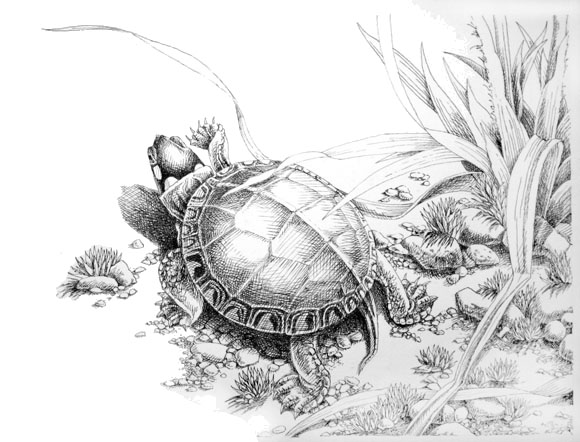Hatchling Painted Turtle on Nest-to-Water Journey
This pen and ink drawing opens my chapter entitled “Hatching” in YEAR OF THE TURTLE (page 126). As I worked on this book, my first to be published, I was becoming more and more aware of the importance of this critical first phase of the lives of the turtle species I had been observing for years, by way of my readings in the scientific literature and, more compellingly, my personal observations.
The nest-to-water journey became a central aspect of my following the seasons of the turtles, and an increasingly important subject of my field work and my writing. This remarkable ecology is treated in some detail in the text accompanying my watercolors on this theme presented in my “Wildlife Studies” series on this web site.

The painted turtle is unique among the species native to my area in having hatchlings that do not, as do all the others, emerge from their nests in late summer and early autumn and set out on these migrations to find the aquatic habitat requisite for their first overwintering.
Some ninety per cent or more of hatchling painted turtles complete their development during incubation in the nest chamber, and break out of their eggshells well before freezing weather, but do not dig out of their nests.
They keep to their small chambers in the earth through the winter, to emerge the following spring. They are able to survive temperatures below freezing (I discuss this further in my “Nest-to-Water Journey” chapter in SWAMPWALKERʼS JOURNAL, pp. 97-98).
In past years, when I screened nests against predators in order to document nesting ecology, I had observations of single painted turtle nests in which some hatchlings left the nest in late summer while others remained in the chamber, only one to three inches below ground, until the following spring.
And I observed hatchlings emerging in May – even into June – as the adult painted turtles were beginning to nest again. They had spent the first year of their lives as embryos developing within eggshells, then fully formed baby turtles pipped from those eggshells and waiting in the earth for the time to dig forth and take up their nest-to-water journeys. This is one more extraordinary adaptation that has enabled turtles to persist through some 220 million years of Earthʼs history.
Bullfrog
It was a bit ironic that at the time I finally got that first book contract I had decided to move away from the detailed watercolors and pen and ink drawings that had comprised the great majority of my art work for several decades. I no longer had the eyes which enabled me to do such fine work without glasses, and it was becoming harder for me to summon the kind of patience it took to produce such work.
There was also that desire, held in abeyance for years, to return to my other modes of drawing and painting, as I discuss in other postings on our studio gallery site (the “magic square” pieces; works in Cubist and Surrealist veins; figure studies; etc.).
But here was a project, writing and illustrating THE YEAR OF THE TURTLE, that I had for years tried to make a reality. It would entail 95 meticulous studies in pen and ink, a drawing for almost every other page. [I had other book proposals with my dedicated literary agent, Meredith Bernstein, but had no idea at the time that there would be four more books to illustrate over the course of more than two decades.]
Pencil drawing, always a favorite medium for me, and perhaps the one I was best at, was considerably less arduous; but for a drawing to hold up strongly enough with printed text it would have to be done in pen and ink.

So I took up again the small pen holder with the finest nib, even finer than a crow quill. In drawing with the most minute detail with such a pen I actually used it with the point upside-down… I will repeat “arduous”. But I was of course so dedicated to doing this book, and certainly realized how lucky I was to have the opportunity, that the patience came, with real devotion.
I am not sure how I came to the decision, what prompted it, but I decided to try a drawing with a technical pen. I had attempted this earlier on, but found it too rigid, too (appropriately enough) mechanical. As little flex as there was with my upside-down points, they brought a freedom of handling that I felt I couldnʼt do without.
But as I experimented with a study using a .13 millimeter point, I found a dexterity and greatly desired precision that had me continue with this technique through all my books. I was able to develop a super-fine cross-hatching that allowed me to gradually build up the darkest darks in a drawing. This was analogous to my work with watercolor, as I used the white paper – in this case a plate-finish vellum – to achieve the lights in my drawing.
So I worked around the spots on a spotted turtleʼs shell, for example, with myriad short pen strokes, having to draw around the light with every stroke, precisely. And I could work up gradations in shading by controlling the degree of fill-in of an area with the cross-hatching, always remembering that I could make things darker, but never lighter, never regain a light, such as that in the eye of this bullfrog.
I always began with a detailed pencil drawing, then took to the pen and ink; and I started with the eye of my living subjects, because if that light were to be lost, the entire drawing would be lost.
| < Turtle Study Sketches |
